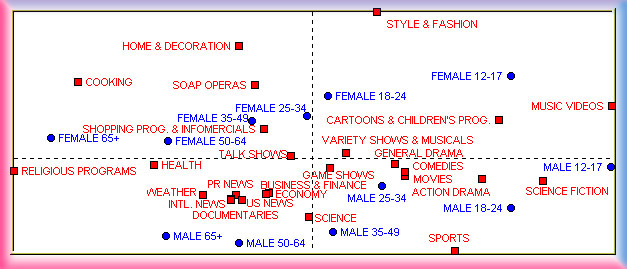
Demographic Profiles of
Television Program Audiences
in Puerto Rico
The television landscape in Puerto Rico is summarized by Nancy Morris in her book (p.142):
Puerto Rico's eight broadcast television stations --- four commercial, two educational, and two religious --- serve the 97 percent of Puerto Rican homes that have television. Locally produced programming constitutes approximately one-half of these stations' output. The rest is made up of imports from Spanish-speaking countries and from the United States. Nearly the entirety of broadcast television is transmitted in the Spanish language; programs from the United States are generally dubbed into Spanish, except sporting programs, which carry Spanish language voice-overs. Cable television is also available throughout the island. ... In contrast to broadcast television, Puerto Rican cable television is dominated by English-language programming on packages of channels from the United States.
To begin, we would like to determine what role, if any, television plays in people's lives. Of course, television is not a monolithic construct, for it is a medium through which various types of content go to various types of people. A crude classification of television content would be a dichotomy of entertainment versus information. We will be referring to some data from the TGI Puerto Rico study, which is a multimedia study conducted by Mediafax Inc to collect demographics, media consumption, product usage and lifestyle information. The study had a sample of 2,055 individuals aged 12 or more, who were interviewed between February and April, 1999. According to this study, 35% of Puerto Ricans 'definitely agree' that television is their main source of entertainment and 24% of them 'definitely agree' that they rely on television to keep them informed. Thus, television plays an important role in the daily lives of many Puerto Ricans.
The dichotomy of entertainment versus information is crude in the sense that there are really many different types of entertainment as well as information program types. Examples of entertainment programs are soap operas, movies, game shows, music videos, etc. Examples of information programs are weather, business and finance, international news, local news, etc. We suspect that these finer program types may not have the same universal appeal for everyone. So the purpose of this note is in fact to determine how preferences for these program types may be different by demographic characteristics.
To begin, we constructed a table to relate demographic information with television program preferences. This table has twelve columns for age/sex groups (male 12-17, male 18-24, male 25-34, male 35-49, male 50-64, male 65+, female 12-17, female 18-24, female 25-34, female 35-49, female 50-64 and female 65+) and 25 rows for the various television formats that people frequently watch. We will not reproduce this table here, because this is a lot of numbers. We use the method of correspondence analysis to produce a two-dimensional map as shown below.

(source: TGI Puerto Rico, Mediafax Inc.)
The correspondence analysis yielded the following graphical representation of the age/sex groups: along the horizontal axis, the groups are sorted by age, with the oldest people on the left and the youngest people on the right; along the vertical axis, the females are on the top half and the males are on the lower half. This graphical representation was created purely on the basis of the television preferences of the survey respondents, as the algorithm has no semantic understanding of the meanings of the labels (such as males 12-17). Thus, the natural age/sex structure was revealed by the algorithm purely from the data structure.
In the same map, the television program types fall into the quadrants where one would expect them to be. For example, music videos falls with teenagers, style/fashion with young females, shopping and home with older females, news with older men and sports with young men. The arrangement is very much in line with our expectations.
We should point out that the television program typology here does not make a distinction between either the source of the program or the language in which it is transmitted. That is, a talk show could be made in Puerto Rico or imported from the USA and it could be in Spanish or English. These factors may in fact affect the receptivity of a television program. Morris quotes an interviewee (p. 143)
"Cable TV has put the English language in every living room ... the child who is developing in a society of cable TV, begins to enjoy and understand the humor, American humor, the American way of life, identifies with the American ideal, ... the clothes, going to the beach without a shirt on. And sometimes here ... one goes to the beach and sees Latinos lying out in the sun ... That is an imitation; it's learned. But it's not rational; the American who comes here in winter cooks in the sun because he or she comes escaping from the cold ... But we don't need to lie out on the beach, we need to get out of the sun ... because this is a tropical country."
However, Morris also notes an oddity in that the objection appears to be directed against the English-language programs that appear on cable television, whereas the dubbed US imports on broadcast television appear to elicit little objection, even if the programming is identical.

On the beach in San Juan, Puerto Rico (photo credit: Pablo
Verdin)
![]()
RELATED ZONA LATINA REFERENCES
PRINT REFERENCES
(posted by Roland Soong on 1/17/00)
(Return to Zona Latina's Home Page)